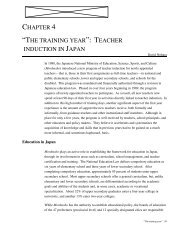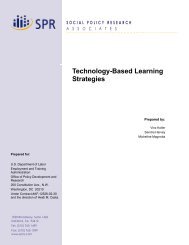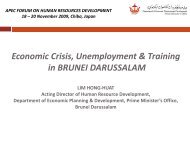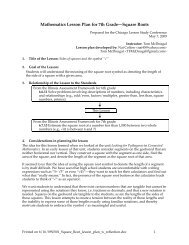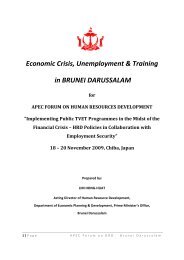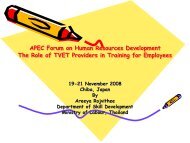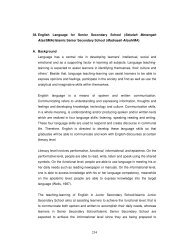Quality Assurance Systems in Asia-Pacific Economic Cooperation
Quality Assurance Systems in Asia-Pacific Economic Cooperation
Quality Assurance Systems in Asia-Pacific Economic Cooperation
Create successful ePaper yourself
Turn your PDF publications into a flip-book with our unique Google optimized e-Paper software.
ENHANCEMENT OF QUALITY ASSURANCE SYSTEMS IN HIGHER EDUCATION IN APEC MEMBER ECONOMIES<br />
The number of days for a typical visit schedule may vary depend<strong>in</strong>g on the size of the unit to<br />
be visited, the depth of assessment to be done, and the approach to the visit. If the <strong>in</strong>stitution<br />
is big or if the visit schedule requires the reviewers to visit all the departments of the <strong>in</strong>stitution<br />
and their facilities, the visit may need more days. In general the visit may take 3 to 5 days.<br />
Review Panel Report<strong>in</strong>g the Outcome<br />
Generally, the reviewers report to the QA system, their assessment provid<strong>in</strong>g evidence they<br />
saw dur<strong>in</strong>g the visit or <strong>in</strong> the self-assessment. In some QA systems, the recommendations of<br />
the review team are approved by the agency and declared as the f<strong>in</strong>al outcome. Some<br />
agencies require the reviewers only to advise the agency or report to the agency their<br />
impressions of the <strong>in</strong>stitution (or program) with reference to the assessment framework. The<br />
govern<strong>in</strong>g body of the QA agency or a body appo<strong>in</strong>ted for this purpose considers the<br />
observations as one of the <strong>in</strong>puts to decide on the outcome.<br />
Whatever option is selected there is a major role for reviewers, and QA systems have checks<br />
and balances <strong>in</strong> place to ensure the credibility of the review outcome. The survey <strong>in</strong>dicates<br />
that experience of the reviewers, balanced composition of the panel, presence of the agency<br />
staff <strong>in</strong> the panel, emphasis on panel consensus, emphasis on evidence-based judgement,<br />
consult<strong>in</strong>g the HEIs on the facts and emphasis of the report etc serve as checks and<br />
balances.<br />
Decision-mak<strong>in</strong>g by the QA System<br />
There are systems where the f<strong>in</strong>al decision depends on the review team’s recommendation<br />
only. The assumption here is that the team has analysed all relevant <strong>in</strong>formation, and<br />
therefore, their recommendation is sufficient as a basis for decision-mak<strong>in</strong>g.<br />
Some systems consider not only the review team’s report but also the self-assessment report<br />
of the <strong>in</strong>stitution or program. The assumption here is that while the external review report is<br />
an important <strong>in</strong>put, the report prepared by the <strong>in</strong>stitution is also important enough to be<br />
considered on its own by the quality assurance agency or its board.<br />
Yet another variation is that the f<strong>in</strong>al decision depends on the review team’s report, the selfassessment<br />
report, and other relevant <strong>in</strong>formation. The quality assurance agency may<br />
consider other relevant <strong>in</strong>formation such as general data on the <strong>in</strong>stitution or the program,<br />
other survey reports, government reports, reports of the professional bodies, submissions by<br />
the other stakeholders or data regard<strong>in</strong>g other <strong>in</strong>stitutions or programs that may help put the<br />
decision <strong>in</strong> perspective. Some systems consider the review team’s report, the selfassessment<br />
report and other relevant <strong>in</strong>formation, and an <strong>in</strong>stitutional response as well.<br />
Outcomes and Implications of the QA Processes<br />
Report<strong>in</strong>g the Outcome<br />
When the purpose of quality assurance is to certify whether an <strong>in</strong>stitution (or program)<br />
qualifies for a certa<strong>in</strong> status such as recognition as an <strong>in</strong>stitution of higher learn<strong>in</strong>g or<br />
approval for offer<strong>in</strong>g degree-grant<strong>in</strong>g programs or eligibility for public fund<strong>in</strong>g, the outcome<br />
may be a simple yes/no or accredited/not-accredited. This is the outcome of most licens<strong>in</strong>g<br />
and accreditation models. Some agencies declare this formal status only.<br />
Some agencies provide the f<strong>in</strong>al outcome on a multi-po<strong>in</strong>t scale. If the quality assurance<br />
exercise asks: “how good are your outputs?” the typical outcome of such an exercise would<br />
be <strong>in</strong> a multi-po<strong>in</strong>t grade - numeric or literal or descriptive. This would be suitable if the quality<br />
assurance agency wishes to focus on outcomes and levels of atta<strong>in</strong>ment. A different way of<br />
look<strong>in</strong>g at a ‘multi-po<strong>in</strong>t scale’ is to use a b<strong>in</strong>ary decision (accredited/not accredited) but<br />
specify different durations for the accredited status.<br />
Some QA activities result <strong>in</strong> reports only. If the quality assurance exercise is clearly focused<br />
on the processes by which an <strong>in</strong>stitution monitors its own academic standards and acts to<br />
assure and enhance the quality of its offer<strong>in</strong>gs, it might result <strong>in</strong> a report, as <strong>in</strong> the case of a<br />
typical quality audit. <strong>Systems</strong> that <strong>in</strong>tend to strengthen their <strong>in</strong>ternal processes for quality may<br />
also benefit from this.<br />
xvi



